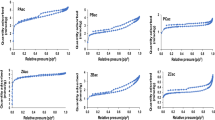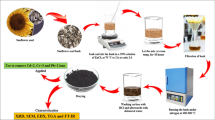Abstract
The adsorption characteristics of natural organic matter (NOM) were investigated on the basis of fluorescence excitation emission matrix (EEM) by using four different coal-based activated carbons (ACs). For each AC, batch adsorption isotherms were analyzed using a modified Freundlich isotherm model on the basis of the fluorescence intensity of three major fluorescence peaks appeared in the fluorescence EEM reported to be reflective of the humic acid-like (P1), fulvic acid-like (P2) and aromatic protein-like (P3) substances, respectively, together with the well-used overall quality indices of dissolved organic carbon (DOC) and ultraviolet absorbance at the wavelength of 260 nm (UV260). It was found that, for all five quality indices, the adsorption capacity differed with the ACs used, and the modified Freundlich isotherm constant K estimated for P1, P2 and P3 was in close correlation with that of the total organic matter evaluated by DOC. Moreover, no matter which AC was concerned, the magnitude of the estimated K and the removal rate over a broader range of AC dose for P3 were apparently smaller than those for P1 and P2, suggesting the adsorbability of aromatic protein-like substances was lower than that of the humic acid-like and fulvic acid-like substances. The dependency of the adsorption capacity of NOM on the volume of pores in some specific size ranges of the ACs was also revealed.






Similar content being viewed by others
References
Baker A (2001) Fluorescence excitation–emission matrix characterization of some sewage-impacted rivers. Environ Sci Technol 35(5):948–953
Chen W, Westerhoff P, Leenheer JA, Booksh K (2003) Fluorescence excitation–emission matrix regional integration to quantify spectra for dissolved organic matter. Environ Sci Technol 37(24):5701–5710
Chu W, Yao D, Gao N, Bond T, Templeton MR (2015) The enhanced removal of carbonaceous and nitrogenous disinfection by-product precursors using integrated permanganate oxidation and powdered activated carbon adsorption pretreatment. Chemosphere 141:1–6
Deng SB, Nie Y, Du ZW, Huang Q, Meng PP, Wang B, Huang J, Yu G (2015) Enhanced adsorption of perfluorooctane sulfonate and perfluorooctanoate by bamboo-derived granular activated carbon. J Hazard Mater 282:150–157
Ebie K, Li FS, Azuma Y, Yuasa A, Hagishita T (2001) Pore distribution effect of activated carbon in adsorbing organic micropollutants from natural water. Water Res 35(1):167–179
Gui HJ, Du HX, Li FS, Wei YF, Yamada T (2015) Characteristics of NOM released from soil under different pH conditions: physicochemical properties and activated carbon adsorbability. J Jpn Soc Civil Eng 71(7):315–322
Henderson RK, Baker A, Murphy KR, Hambly A, Stuetz RM, Khan SJ (2009) Fluorescence as a potential monitoring tool for recycled water systems: a review. Water Res 43(4):863–881
Hyung H, Kim JH (2008) Natural organic matter (NOM) adsorption to multi-walled carbon nanotubes: effect of NOM characteristics and water quality parameters. Environ Sci Technol 42(12):4416–4421
Ip AWM, Barford JP, McKay G (2009) Reactive Black dye adsorption/desorption onto different adsorbents: effect of salt, surface chemistry, pore size and surface area. J Colloid Interface Sci 337(1):32–38
Joshi S, Pant DD (2014) Steady state and time-resolved fluorescence spectroscopy of quinine sulfate dication bound to sodium dodecylsulfate micelles: fluorescent complex formation. J Lumin 145:224–231
Karanfil T, Kilduff JE, Schlautman MA, Weber WJ (1996) Adsorption of organic macromolecules by granular activated carbon. 1. Influence of molecular properties under anoxic solution conditions. Environ Sci Technol 30(7):2187–2194
Lee N, Amyb G, Croue JP (2006) Low-pressure membrane (MF/UF) fouling associated with allochthonous versus autochthonous natural organic matter. Water Res 40:2357–2368
Leenheer JA, Croue JP (2003) Peer reviewed: characterizing aquatic dissolved organic matter. Environ Sci Technol 37(1):18–26
Lenhardt L, Bro R, Zekovic I, Dramicanin T, Dramicanin MD (2015) Fluorescence spectroscopy coupled with PARAFAC and PLS DA for characterization and classification of honey. Food Chem 175:284–291
Li FS, Yuasa A, Ebie K, Azuma Y, Hagishita T, Matsui Y (2002) Factors affecting the adsorption capacity of dissolved organic matter onto activated carbon: modified isotherm analysis. Water Res 36(18):4592–4604
Li FS, Yuasa A, Chiharada H, Matsui Y (2003) Polydisperse adsorbability composition of several natural and synthetic organic matrices. J Colloid Interface Sci 265:265–275
Li FS, Yuasa A, Muraki Y, Matsui Y (2005) Impacts of a heavy storm of rain upon dissolved and particulate organic C, N and P in the main river of a vegetation-rich basin area in Japan. Sci Total Environ 345(1):99–113
Liu T, Chen ZL, Yu WZ, You SJ (2011) Characterization of organic membrane foulants in a submerged membrane bioreactor with pre-ozonation using three-dimensional excitation–emission matrix fluorescence spectroscopy. Water Res 45:2111–2121
McDonald S, Bishop AG, Prenzler PD, Robards K (2004) Analytical chemistry of freshwater humic substances. Anal Chim Acta 527(2):105–124
Mostofa KMG, Yoshioka T, Konohira E, Tanoue E (2007) Photodegradation of fluorescent dissolved organic matter in river waters. Geochem J 41(5):323–331
Namasivayam C, Kavitha D (2002) Removal of Congo Red from water by adsorption onto activated carbon prepared from coir pith, an agricultural solid waste. Dyes Pigm 54(1):47–58
Ohno T, Amirbahman A, Bro R (2007) Parallel factor analysis of excitation–emission matrix fluorescence spectra of water soluble soil organic matter as basis for the determination of conditional metal binding parameters. Environ Sci Technol 42(1):186–192
Shen J, Schafer AI (2015) Factors affecting fluoride and natural organic matter (NOM) removal from natural waters in Tanzania by nanofiltration/reverse osmosis. Sci Total Environ 527:520–529
Sotelo JL, Ovejero G, Rodríguez A, Alvarez S, Galan J, García J (2014) Competitive adsorption studies of caffeine and diclofenac aqueous solutions by activated carbon. Chem Eng J 240:443–453
Stedmon CA, Markager S, Bro R (2003) Tracing dissolved organic matter in aquatic environments using a new approach to fluorescence spectroscopy. Mar Chem 82:239–254
Sudoh R, Islam MS, Sazawa K, Okazaki T, Hata N, Taguchi S, Kuramitz H (2015) Removal of dissolved humic acid from water by coagulation method using polyaluminum chloride (PAC) with calcium carbonate as neutralizer and coagulant aid. J Environ Chem Eng 3(2):770–774
Sun YN, Gao B, Yao Y, Fang J, Zhang M, Zhou YM, Chen H, Yang L (2014) Effects of feedstock type, production method, and pyrolysis temperature on biochar and hydrochar properties. Chem Eng J 240:574–578
Urano K, Yamamoto E, Tsunatani K (1982) Granular activated carbon adsorption of humic acid. J Jpn Water Works Assoc 51(6):37–47
Wang YL, Yang CM, Zou LM, Cui HZ (2015) Spatial distribution and fluorescence properties of soil dissolved organic carbon across a riparian buffer wetland in Chongming Island, China. Pedosphere 25(2):220–229
Zhang X, Li AM, Jiang ZM, Zhang QX (2006) Adsorption of dyes and phenol from water on resin adsorbents: effect of adsorbate size and pore size distribution. J Hazard Mater 137(2):1115–1122
Zhu GC, Yin J, Zhang P, Wang XF, Fan GD, Hua B, Ren BZ, Zheng HL, Deng BL (2014) DOM removal by flocculation process: fluorescence excitation–emission matrix spectroscopy (EEMs) characterization. Desalination 346:38–45
Acknowledgement
The authors thank Mr. Pham Xuan Thanh, a master course student of the Graduation School of Engineering at Gifu University, for his cooperation during the adsorption experiment.
Author information
Authors and Affiliations
Corresponding author
Additional information
Editorial responsibility: Hari Pant.
Rights and permissions
About this article
Cite this article
Gui, H.J., Li, F.S., Wei, Y.F. et al. Adsorption characteristics of natural organic matter on activated carbons with different pore size distribution. Int. J. Environ. Sci. Technol. 15, 1619–1628 (2018). https://doi.org/10.1007/s13762-017-1536-3
Received:
Revised:
Accepted:
Published:
Issue Date:
DOI: https://doi.org/10.1007/s13762-017-1536-3




